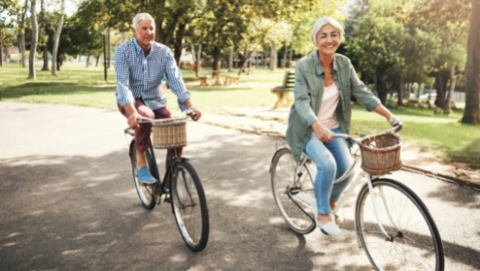Physical Activity and Aging
By: Christina Pay, Extension Assistant Professor

There is a tendency in adults to become more sedentary as they age. Slowing down can be due to a variety of things such as poor health, pain, or fear of falling. However, being active as you age becomes more important to your health and well-being. Currently, 3.2 million deaths around the world each year are attributed to inactivity of older adults (2). There is a direct link between physical inactivity and heart disease, diabetes, high blood pressure, loss of muscle mass, strength, and endurance as well as a decline in balance, and cognitive performance (2). Increasing physical activity is the most important intervention to improve health in all age groups, and for older adults, it becomes an important factor in extending life and maintaining independence. Consistent physical activity can improve physical health and has positive benefits for mental health and cognitive abilities, a sense of independence, social well-being, and personal learning and growth (3). One study also found that physical activity can contribute to a longer life, even if you wait to start exercising until you are a senior adult (4).
According to the Centers for Disease Control and Prevention, adults 65 and older need:
At least 150 minutes of moderate intensity activities per week.
This includes aerobic activity. Suggested activities could include:
- Walking or hiking
- Some forms of yoga
- Some yard work, such as raking and pushing a lawn mower
- Bicycle riding (stationary or outdoors)
- Water aerobics
Two days per week of muscle strengthening exercise.
Suggested activities could include:
- Lifting weights
- Working with resistance bands
- Doing exercises that use your body weight for resistance (push-ups, sit-ups)
- Heavy gardening (digging, shoveling)
- Some forms of yoga
Three days of balance activities. These help to prevent falling. Suggested activities could include:
- Walking backward
- Standing on one leg
- Doing Tai Chi
- Using a wobble board.
- Strengthening back, abdomen and leg muscles also improves balance.
The following websites offer suggestions on how to keep moving and incorporate exercise into your daily routine:
- How Older Adults Can Get Started with Exercise
- Fun Ways for Older Adults to Stay Physically Active
- Exercising with Chronic Conditions
The National Institute on Aging suggests five tips to help older adults stay motivated to exercise:
- Find ways to fit exercise into your day. You are more likely to get moving if exercise is a convenient part of your day.
- Do activities you enjoy to make it more fun. Be creative and try something new!
- Make it social. Find a real or virtual “exercise buddy” to help keep you going and provide emotional support.
- If there is a break in your routine, get back on track. Start slowly and gradually build back up to your previous level of activity. Ask your family and friends for support.
- Keep track of your progress. Make an exercise plan and don’t forget to reward yourself when you reach your goals.
Remember that consistent physical activity can improve physical and mental function and can reverse the effects of some chronic diseases. Added together, these benefits help keep older people mobile and independent in their older years (5).
For more tips and information on safe exercise visit: National Institute on Aging: Exercise and Physical Activity
References
- Meola, A. (2022, February 7). The aging US population is creating many problems—especially
regarding elderly healthcare issues. Insider. Retrieved April 11, 2022, from
https://www.businessinsider.com/aging-population-healthcare - Taylor, D. (2014). Physical activity is medicine for older adults. Postgraduate Medical Journal,
90(1059), 26-32. - Yen, H.-Y., & Lin, L.-J. (2018). Quality of life in older adults: Benefits from the productive engagement in physical activity. Journal of Exercise Science & Fitness, 16, 49-54.
- Rennemark, M., Jogréus, C., Elmståhl, S., Welmer, A. K., Wimo, A., & Sanmartin-Berglund, J.
(2018). Relationships Between Frequency of Moderate Physical Activity and Longevity: An 11-Year Follow-up Study. Gerontology & geriatric medicine, 4, 2333721418786565. https://doi.org/10.1177/2333721418786565 - McPhee, J. S., French, D. P., Jackson, D., Nazroo, J., Pendleton, N., & Degens, H. (2016). Physical activity in older age: perspectives for healthy ageing and frailty. Biogerontology, 17, 567-580.
- Exercise and physical activity. (n.d.). National Institute on Ageing. Retrieved April 11, 2022, from
https://www.nia.nih.gov/health/exercise-physical-activity - How much physical activity do older adults need? (n.d.). Centers for Disease Control and Prevention.
Retrieved April 11, 2022, from https://www.cdc.gov/physicalactivity/basics/older_adults/index.htm

